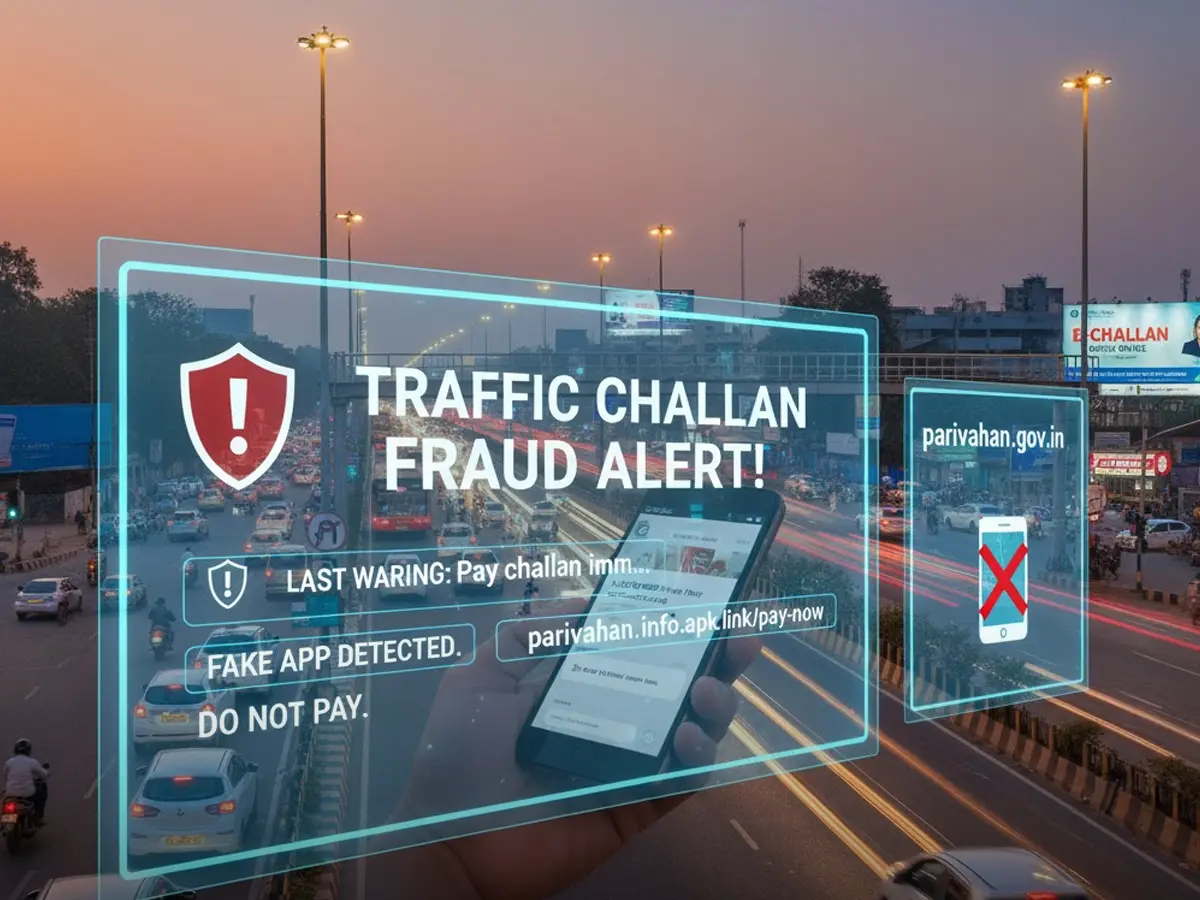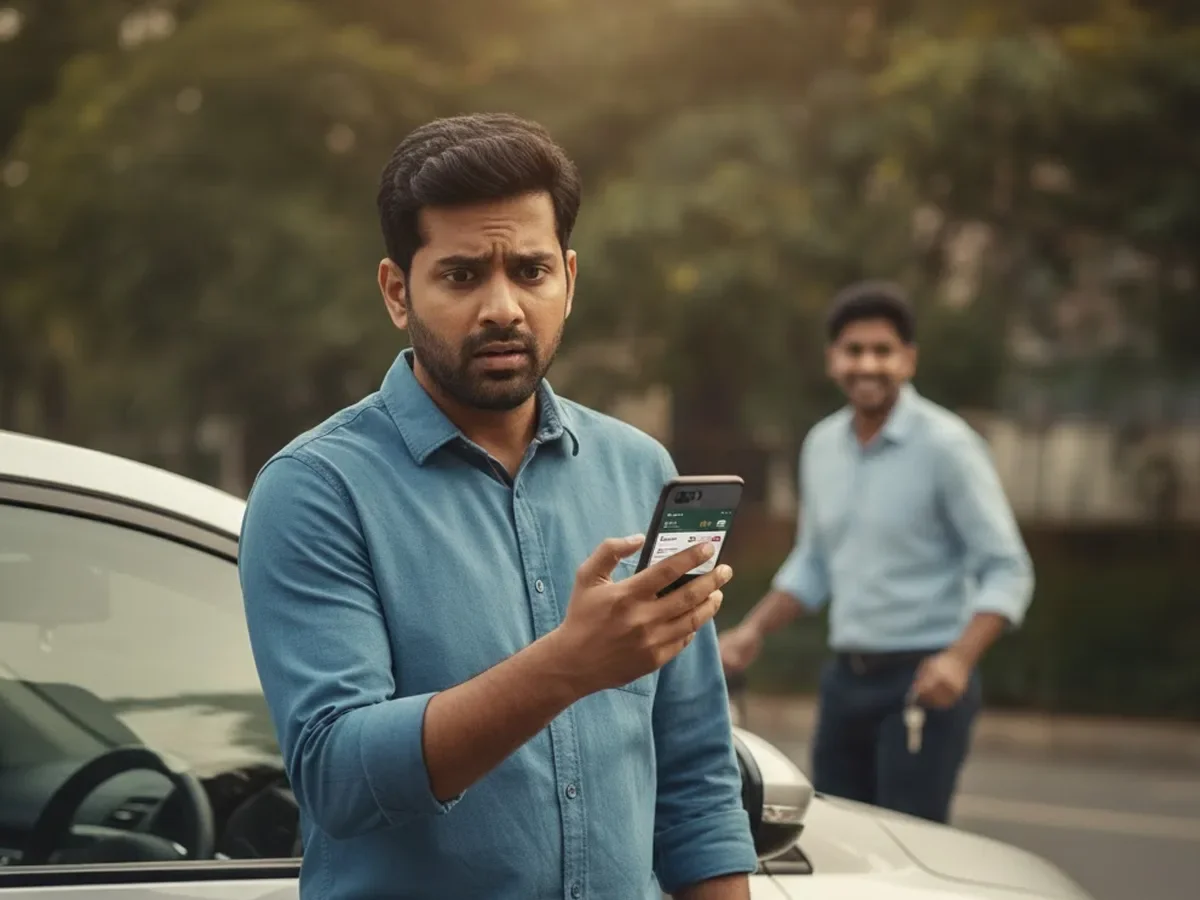

Beware of Fake Challan Apps & Scams: How to Spot Danger Before You Pay
- 1Fake apps and messages are fuelling a rise in traffic challan fraud alert cases
- 2Scammers use WhatsApp, SMS and fake websites that look like real e-challan portals
- 3Always verify fines using trusted sources and check challan online before paying
It starts with a simple message saying, “You have a pending traffic fine, pay immediately to avoid licence suspension.” The link looks official, the logo seems legit, and the urgency feels real. Within minutes, you have entered your details or installed a small app, and just like that, your money and data are gone. Across India, cyber police are reporting an alarming surge in such traffic challan fraud alert cases.
These are not some random phishing attempts. They are professionally designed and organised frauds that are built to resemble actual government portals, such as Parivahan or state police websites. Others even include fake customer care contact numbers and downloadable APKs that are masqueraded as official RTO apps. It is no longer a matter of being careless but a matter of being aware of deception that is getting smarter day by day.
The Way the Scam Actually Works
Let’s dissect the way these fraudsters work because once you know the pattern, it is easy to spot.
- The Bait: You get a WhatsApp message or SMS that says that you owe a challan, and it usually includes your vehicle number or a fake-looking ID.
- The Hook: The message contains a payment link or APK that states that it is an official traffic application.
- The Trap: When you click on it, it takes you to a cloned Parivahan portal or police portal that has the ability to steal card, UPI or banking information.
The Damage: In a few minutes, the accounts are accessed, data is compromised, and the victims lose money, all under the illusion of paying a real fine.
This is a traffic challan fraud alert and it works because it resembles authenticity. It mirrors the appearance of actual government pages, fonts, URLs, and everything else.
Why It’s Spreading Fast
The majority of drivers are accustomed to paying online and getting digital notifications. Fraudsters take advantage of that familiarity.
- They use realistic vehicle details scraped from leaked databases.
- They craft urgent messaging which says, “Pay in 24 hours or your licence will be blocked.”
- They push malicious APKs, which, once installed, access your phone permissions and banking apps.
Police across Delhi, Hyderabad, and Pune have issued repeated traffic challan fraud alert advisories, warning users not to install any traffic-related apps they receive through SMS or social media.
How to Spot a Scam Before You Click?
Here is how you identify a scam before it identifies you:
- Check the domain: Genuine challan portals always end with .gov.in or .org and not “.com” or “.info.”
- Never download APKs: No government department sends payment apps over WhatsApp.
- Look for spelling errors or urgency: Phrases like “Pay Immediately” or “Last Warning” are clear red flags.
- Avoid third-party payment requests: Official sites redirect only through trusted payment gateways.
Cross-check once: Before clicking any link, always verify the challan on official sources using e challan check online.
These five checks can save you days of financial stress and take less than a minute.
Steps to Verify a Real Challan
In case of any uncertainty, always refer to the source. Here is your 90-second authenticity checklist:
- Visit your state’s official traffic police website or the Parivahan e-challan portal.
- Enter your vehicle number or RC details.
- View fines with official timestamps and photo evidence.
- Pay only if the site uses secure gateways like BHIM, UPI, or net banking directly within the portal.
Save your payment receipt because it’s your only valid proof.
The e challan check online tool of CARS24 is also a fast, safe, and transparent way to check and make payment in a reliable way.
What To Do If You’ve Been Scammed
If you have already clicked on a suspicious link or installed an APK, do the following as soon as possible:
- Disconnect the internet and uninstall the app immediately.
- Contact your bank to block UPI or card transactions.
- Report the case to your nearest cyber cell or lodge a complaint at cybercrime.gov.in.
Change all passwords linked to UPI, email, and banking apps.
Law enforcement advises reporting a traffic challan fraud alert promptly because early reporting improves recovery chances.
Steps to Stay Safe
Confusion is the breeding ground of cybercriminals. The better informed you are, the harder you are to target. Here is what experts recommend:
- Save only official URLs for your state’s e-challan portal.
- Don’t share OTPs, UPI PINs, or transaction IDs over calls.
- Install banking and payment apps only from Google Play or Apple App Store.
Treat any message with urgency or threat of arrest as suspicious.
Remember that government portals do not make calls, send messages or threaten drivers. They can only send notifications via registered platforms or confirmed SMS IDs.
Summary
The traffic challan fraud alert wave in India shows how convenient it has become for scammers to exploit trust in digital governance. What appears to be official at first sight might be a phishing link that will empty your account within a few seconds.
Always check twice before paying and when unsure, do not follow the link and check e challan online via official portals. In 2025, awareness is not a choice: it is your initial line of defence against cybercrime disguised as convenience.
Frequently Asked Questions
Expand all



























